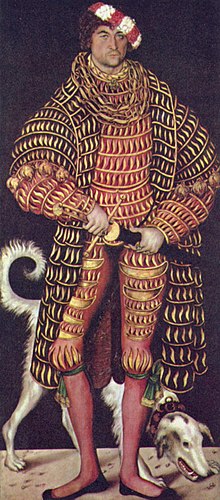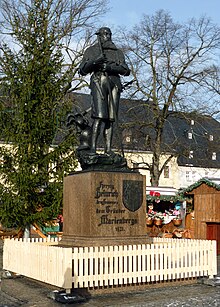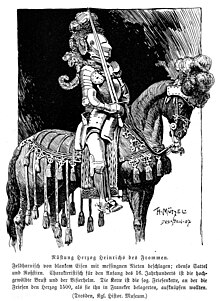Heinrich (Saxony)




Heinrich the Pious (born March 16, 1473 in Dresden ; † August 18, 1541 ibid) from the house of the Albertine Wettins was Duke of Saxony and Sagan from 1539 to 1541 and is also counted as Heinrich V in his capacity as Margrave of Meissen . He introduced the Reformation in Albertine Saxony ; first in 1537 in the territories of Albertine Saxony administered by him and in 1539, after taking over the rule, in the rest of the duchy.
Life
Origin and family
Heinrich was the second son of Duke Albrecht the Courageous of Saxony (1443–1500), who had founded the Albertine line of the Saxon house in 1485 in the Leipzig division . Heinrich's mother Sidonie (1449-1510) was a daughter of King Georg Podiebrad of Bohemia from his marriage to Kunigunde von Sternberg .
Heinrich's older brother George the Bearded inherited his father as Duke of Saxony in 1500; his older sister Katharina had been married to Archduke Siegmund of Austria since 1484 ; his younger brother Friedrich became Grand Master of the Teutonic Order in 1498 .
Governor of Friesland
In 1498 Heinrich went on a pilgrimage to Jerusalem and was appointed governor of Friesland the following year by his father . In 1503 he made a pilgrimage on the Way of St. James to Santiago de Compostela . As a result of unreasonable tax demands, however, the Frisians opposed his rule and Heinrich renounced his rule there in 1505 after he was temporarily besieged in the Franeker residence .
Albrecht the courageous had determined in his will ("fatherly order") that his older brother Georg had to compensate him in the event of the loss of Friesland with the castle, city and offices of Freiberg and Wolkenstein with an annual pension of initially 12,500 guilders.
Freiberg
After the "brotherly contract" with Georg in 1505, Heinrich got the non-contiguous offices of Freiberg and Wolkenstein and moved into Freudenstein Castle in Freiberg . He was an avid hunter and was a passionate collector of handguns and artillery. On July 6, 1512 Heinrich married Princess Katharina (1487–1561), daughter of Duke Magnus II of Mecklenburg in Freiberg . Elisabeth von Rochlitz , the Freiberg City Council and the Ernestines of the family helped over financial bottlenecks .
In 1521 Heinrich founded the mining town of Marienberg in the Ore Mountains after rich silver ore deposits were discovered there. He commissioned Ulrich Rülein von Calw , who planned the regular urban layout with a central, 1-hectare market square and streets going off vertically. Next to the town hall there, Heinrich had his own house built, in which he often stayed with his family.
Introduction of the Reformation
In 1536, after many years of urging his wife Katharina, Heinrich confessed to Luther's teaching . Supported by Elector Johann Friedrich and Councilor Adam von Schönberg, he introduced the Reformation in his territories . Heinrich came in contradiction to his brother George the Bearded, who as a declared enemy of Luther continued to cling to Catholicism and had his younger brother monitored.
On New Year's Day in 1537, the Lord's Supper was served for the first time in Freiberg Cathedral . In the same year Heinrich and his eldest son, through the mediation of his wife, became members of the Schmalkaldic League . George the Bearded, who had initially cut funds and prevented the evangelical clergy from being paid, finally gave in in the fall of 1538 after his sons Johann and Friedrich had died and Heinrich had been established as his presumptive successor. However, he was unable to win Heinrich over for the Catholic League and maintaining the old faith in the country.
Duke of Saxony
At the age of 66, Heinrich took over the rule of the duchy from his brother Georg. During his reign, Protestantism became the state religion in Albertine Saxony. This made it official in all of Saxony, because the Ernestines had already made this decision in 1525/1527. In doing so, Heinrich did not use the ordinance of the church service in Saxony, but the so-called "Heinrichs Agende", and the visitations were also carried out under his own direction. Those who refused to accept the new religion were expelled from the country or imprisoned. On May 25, 1539, the inauguration ceremony of the Reformation took place in Leipzig in the presence of Martin Luther.
In November 1539 Heinrich took part in his only state parliament in Chemnitz . Thus funds were granted to him, he had in his religious coercion have to give during the Reformation Introduction and was allowed without the consent of the stands to take any alliance. Together with the Elector of Saxony, Heinrich managed to get the bishops to renounce the imperial status, to which the Bishop of Meissen had put up bitter resistance. The bishops' complaint to the emperor finally confirmed their imperial immediacy . 11 days before his death, Heinrich appointed his eldest son to be co-regent. In his will he committed his family to be faithful to the Augsburg denomination . Heinrich was the first Wettin to be buried in Freiberg Cathedral.
Heinrich was one of the most powerful Wettins whose most important decision - the introduction of the Reformation in Albertine Saxony - has shaped the country to this day. This stands in strange contrast to his rather limited abilities, especially since his much more important brother Georg, who was more active in Reich politics, was denied such an aftereffect.
progeny
Heinrich had the following children from his marriage to Katharina:
- Sibylle (1515–1592)
- ⚭ 1540 Duke Franz I of Saxony-Lauenburg (1510–1581)
- Aemilia (1516–1591)
- ⚭ 1533 Margrave Georg the Pious of Brandenburg-Ansbach (1484–1543)
- Sidonie (1518–1575)
- ⚭ 1545 Duke Erich II of Braunschweig-Calenberg (1528–1584)
- Moritz (1521–1553), Elector of Saxony
- ⚭ 1541 Princess Agnes of Hesse (1527–1555)
- ⚭ 1548 Princess Anna of Denmark and Norway (1532–1585)
ancestors
| Pedigree of Heinrich the Pious | ||||||||
|---|---|---|---|---|---|---|---|---|
| Great-great-grandparents |
Margrave |
Duke |
Duke |
Boček II of Podebrady (–1417) |
? |
? |
||
| Great grandparents |
Elector Friedrich I of Saxony (1370–1428) |
Duke Ernst the Iron (1377–1424) |
Viktorin von Podiebrad (1403–1427) |
Smil von Sternberg (–1431) |
||||
| Grandparents |
Elector Friedrich II. (1412–1464) |
King George of Podebrady (1420–1471) |
||||||
| parents |
Duke Albrecht the Courageous (1443–1500) |
|||||||
|
Henry the Pious |
||||||||
literature
- Elisabeth Werl : Heinrich the Pious. In: New German Biography (NDB). Volume 8, Duncker & Humblot, Berlin 1969, ISBN 3-428-00189-3 , pp. 391-393 ( digitized version ).
- Heinrich Theodor Flathe : Heinrich the Pious . In: Allgemeine Deutsche Biographie (ADB). Volume 11, Duncker & Humblot, Leipzig 1880, p. 601 f.
- Konstantin Enge: Heinrich von Sachsen (1473–1541) , in: Rule and change of faith. The Prince Reformation in the Empire and Europe in 28 biographies, Universitätsverlag Winter Heidelberg, 2016, pp. 215–229
- Karl Friedrich August Nobbe : Heinrich the Pious: a contribution to the Saxon Reformation jubilation celebration in 1839 , published by Chr. Ernst Kollmann, 1839
- Yves Hoffmann and Uwe Richter (eds.): Duke Heinrich the Pious (1473–1541) , Sax-Verlag, 2007
- Erich Brandenburg : Duke Heinrich the Pious of Saxony and the religious parties in the empire (1577–1541) , Baensch, 1896
- Karl Wilhelm Böttiger : Duke Heinrich the Pious of Saxony: Biographical sketch , 1824 ( online )
- CA Holzhaus : Duke Heinrich the Pious, the founder of Marienberg: a contribution to the history of the Ore Mountains , Engelmann, 1889
- Reinhold Röhricht , Enno Littmann , Leonhard Bauer : The trip to Jerusalem of Duke Heinrich the Pious of Saxony (1498) , 1901
- Frank-Lothar Kroll : The rulers of Saxony: margraves, electors, kings 1089–1918 , p. 85 ff. ( Digitized version )
Web links
- Konstantin Enge: Heinrich (the pious) . In: Institute for Saxon History and Folklore (Ed.): Saxon Biography .
- Literature by and about Heinrich in the Saxon Bibliography
- http://www.die-sachsen-kommen.de/wetthtm/albertiner.htm
- Pilgrimage on the Way of St. James ( Memento from November 19, 2013 in the Internet Archive )
| predecessor | Office | successor |
|---|---|---|
| George |
Duke of Saxony 1539 - 1541 |
Moritz |
| personal data | |
|---|---|
| SURNAME | Heinrich |
| ALTERNATIVE NAMES | Heinrich the Pious; Heinrich V (Margrave of Meissen) |
| BRIEF DESCRIPTION | Duke of Saxony as well as Sagan and Margrave of Meissen |
| DATE OF BIRTH | March 16, 1473 |
| PLACE OF BIRTH | Dresden |
| DATE OF DEATH | August 18, 1541 |
| Place of death | Dresden |
